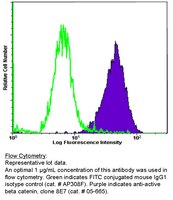05-665-25UG Sigma-AldrichAnti-Active-b-Catenin Antibody, (anti ABC) Antibody, clone 8E7
Anti-Active-β-Catenin (anti-ABC) Antibody, clone 8E7 is a well characterized Mouse Monoclonal Antibody. This highly published mAb also known as Anti-Catenin beta-1 readily detects beta-Catenin & has been validated in FC, ICC, IHC, IHC(P) & WB.
More>> Anti-Active-β-Catenin (anti-ABC) Antibody, clone 8E7 is a well characterized Mouse Monoclonal Antibody. This highly published mAb also known as Anti-Catenin beta-1 readily detects beta-Catenin & has been validated in FC, ICC, IHC, IHC(P) & WB. Less<<Recommended Products
Overview
| Replacement Information |
|---|
Key Specifications Table
| Species Reactivity | Key Applications | Host | Format | Antibody Type |
|---|---|---|---|---|
| H, M, R | FC, ICC, IHC, IH(P), WB | M | Purified | Monoclonal Antibody |
| References |
|---|
| Product Information | |
|---|---|
| Format | Purified |
| Control |
|
| Presentation | Purified mouse monoclonal IgG1k in buffer containing 0.1 M Tris-Glycine, pH 7.4, 15 mM NaCl and 0.05% sodium azide |
| Quality Level | MQ100 |
| Physicochemical Information |
|---|
| Dimensions |
|---|
| Materials Information |
|---|
| Toxicological Information |
|---|
| Safety Information according to GHS |
|---|
| Safety Information |
|---|
| Packaging Information | |
|---|---|
| Material Size | 25 μg |
| Transport Information |
|---|
| Supplemental Information |
|---|
| Specifications |
|---|
| Global Trade Item Number | |
|---|---|
| Catalog Number | GTIN |
| 05-665-25UG | 04054839337680 |












